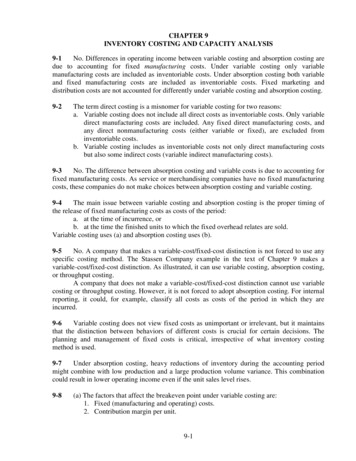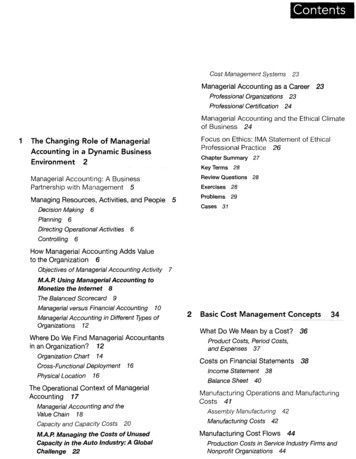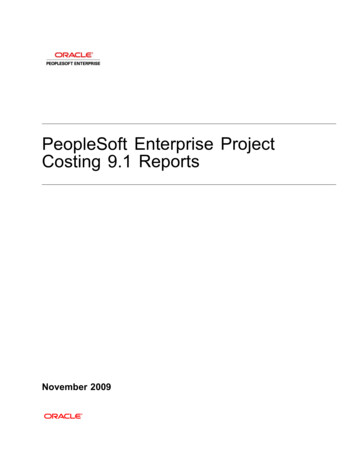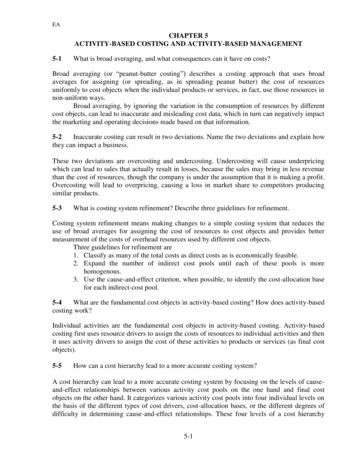
Transcription
International Journal of Trade, Economics and Finance, Vol. 1, No. 2, August, 20102010-023XFactors Influencing Activity-Based CostingSuccess: A Research FrameworkZhang Yi Fei and Che Ruhana IsaAbstract—In today’s advanced manufacturing andcompetitive environment, accurate costing information iscrucial for all the kinds of businesses, such as manufacturingfirms, merchandizing firms, and service firms. Argued to besuperior to the traditional volume-based costing system,Activity-Based Costing system (ABC) has increasingly attractedthe attention of practitioners and researchers alike as one of thestrategic tools to aid managers for better decision making. Thebenefits of ABC system and its impacts on companies’performance have motivated numerous empirical studies onABC system and it is considered as one of the most-researchedmanagement accounting areas in developed countries. Previousresearch on ABC have examined pertinent issues related toABC implementation such as the levels of ABC adoption invarious countries, the reasons for implementing ABC, theproblems related to ABC and the critical success factorsinfluencing ABC. This paper reviews the research on ABCcarried out within the last decade, from 1995-2008, and fromthe review research gaps are identified. Specifically, this paperexamines the selection of factors influencing successful ABCimplementation, variables used by previous research and thedefinitions and operationalization of the variables. The reviewreveals that past research concentrated mainly on behavioral,organizational, and technical variables as the maindeterminants of ABC success but very little research have beendone to examine the roles of organizational culture andstructure. Based on the research gaps identified, a researchframework for future research is provided.Index Terms—Advanced ManufacturingActivity-Based Costing, ABC SuccessEnvironment,I. INTRODUCTIONIn today’s competitive and continually changing businessenvironment, firms need to be vigilant of the impacts of thechanges in the business environment and devise appropriatestrategies to survive and prosper. Advancements inmanufacturing and communication technologies havedrastically changed the ways businesses conduct theiractivities. Adoption of advanced manufacturing technologiessuch as robotics and computerized manufacturing haveresulted in significant changes in the manufacturing coststructure which have led academics and practitioners to arguethat the traditional costing methods are no longer sufficientwithin this new manufacturing environment [1] (Johnson andKaplan, 1987). This had resulted in the change from thetraditional volume-based cost model to new costing methodssuch as Activity Based Costing (ABC) [2].Due to its ability in providing more accurate costinginformation and enhancing firms’ performance, ABC isbecoming more and more popular [3-7] ABC aims to provideaccurate costing information to managers to allocate activitycosts to products and services by applying cost drivers [8].Academics who advocate ABC, such as, Cooper and Kaplan[9], and Swenson [10] argue that it provides more accuratecost data needed to make appropriate strategic decisionsabout product mix, sourcing, pricing, process improvement,and evaluation of business process performance. Theseclaims have led many firms to adopt ABC systems [8].The benefits of ABC and its positive impact on firm’sperformance motivated a numerous studies which examinedvarious aspects of ABC. Among such studies are McGowan[11] who assessed the integrity of ABC success, Innes andMitchell [4, 12] and Yanren [13] who conducted research onfactors affecting ABC adoption, and Shield [3], Shields andMcEwen [14], Gosselin [15] and Baired et al.[16, 17]whoconcentrated on factors influencing ABC success especiallyat the implementation stage.However, there is mounting evidence that suggests most offirms are experiencing problems in implementing ABC and,in some extreme cases, ABC implementation is notsuccessful [3], which later resulted in abandoning the ABCsystems altogether [15]. Questions arise as to why ABCimplementation is successful in certain companies and failsin others. Based on the contingency theory, researchers haveargued that the reasons for different degrees of ABC successcould be due to the different contextual factors faced by eachfirm. These have led researchers to recognize assessingfactors that influence ABC success implementation as animportant research area. The following are among theresearch that have been carried out to examine factors thatinfluence ABC success: Anderson [18]; Shield [3];McGowan and Klammer [19]; Krumwiede [20]; andAnderson and Young [21]This article has two main objectives; the first objective isto identify research gaps based on the revision of previousresearch and the second objective is to propose theoreticalresearch framework for current research. This article isorganized as follows: Section II presents a discussion ofselected articles related to factors influencing ABCimplementation and gaps or limitations of previous studiesand suggestions for current research are stated in the sectionIII and IV. The framework for current research is provided insection V, Section VI defines each research variable and thefinal section presents the conclusion.II. PREVIOUS RESEARCHIn this section, selected ABC implementation empirical144
International Journal of Trade, Economics and Finance, Vol. 1, No. 2, August, 20102010-023Xstudies, which spanned 1995-2008 periods, were collectedfrom four prominent refereed accounting research journals,in management accounting field: Journal of ManagementAccounting Research, Accounting, Organizations andSociety, Management Accounting Research and BritishAccounting Review. Factors used by previous research toinvestigate the effect on ABC success implementation aresummarized, and stage of ABC implementation also isoutlined.A. Technical VariablesEarly studies of ABC adoption and implementationundertaken by previous researchers concentrated ontechnical factors, such as identification of main activities,selection of cost drivers, problem in accumulating cost data.Example of these research are Cooper [9], Morrow andConnelly [22].However, technical factors alone may not be adequate toexplain the factors influencing ABC success implementation.Cooper et al. [23] argued that the key problem during ABCimplementation stage is that companies only focus ontechnical factors. They suggested that to make ABCimplementation more effective, non-technical factors such asinvolvement of non-accounting in ABC implementationprocess, top management championship, adequate trainingprogram to employees about the objectives and benefits ofABC should be emphasized as well.Similar opinions were expressed by Shield [3] and Shieldsand McEwen [14]. Shield (1995) found no significantrelationship between technical factors and ABC success.Shields and McEwen [14] also highlighted that sole emphasison the architectural and software design of ABC systemsleads to the failure of ABC implementation. Therefore manyresearchers have suggested that new variables should beconsidered to investigate factors influencing ABC success.B. Contextual, Behavioral and Organizational VariablesRecognizing the research gaps in identifying factors thatmay affect ABC success, academicians shifted their focusesfrom technical factors to other variables, such as contextual,behavioral and organizational, culture, as well asorganizational structure.Anderson [18] conducted a longitudinal investigation ofABC process in General Motor (GM) from a period of 1986to 1993. In his research, he examined the effects oforganizational variables and contextual variables, andsegmented ABC implementation into four major stages,initiation, adoption, adaptation and acceptance. He found thatorganizational factors, such as top management support andtraining for the ABC system affected various stages of ABCsignificantly, while contextual variables, such as competition,relevance to managers’ decisions and compatibility withexisting systems produced different degree of impact ondifferent stages of ABC.Shield [3] examined the relationships between diversity ofbehavioral, organizational and technical factors and thesuccess of ABC implementation. She employed Shield andYoung’s [24] framework and summarized behavioral andorganizational variables as top management support,adequate resources, training, link ABC system toperformance evaluation and compensation, non-accountingownership, link ABC to competitive strategies as well asclarity of ABC objectives. She found that top managementsupport, linkage to quality initiatives and to personalperformance measure (pay/appraisal), implementation oftraining and resource adequacy were the significantpredictors in explaining ABC success. She also found thattechnical variables were not associated with ABC success.Shield’s findings are supported by other researchers, suchas Shield and McEwen [14], who argued that a significantcause for unsuccessful implementations of ABC of severalcompanies could be due to the emphasis of architectural andsoftware design of the ABC system and less attention givento behavioral and organizational issues, which wereidentified by Shield [3]. Krumwiede and Roth [25] also statedthat barriers of ABC implementation can be overcome iffirms could give importance to behavioral and organizationalvariables identified by Shield [3]. Similarly, Norris [26]agreed with Shield’s [3] findings that the association betweenABC success and behavioral and organizational variables isstronger than with technical variables. She furtherhighlighted that the impact of behavioral, organizational andtechnical should be focused at individual level.McGowan and Klammer [19] conducted a survey of 53employees from 4 targeted sites in the U.S. to examinewhether employees’ satisfaction levels are associated withABC implementation by They also measured theirperceptions of the factors associated with the degree ofsatisfaction, such as top management support; the degree ofinvolvement in the implementation process; objectivesclearly stated; objectives shared; training; linkage toperformance evaluation system; adequate resources;information quality and preparer over user.Their resultsindicated that employees’ satisfaction with ABCimplementation was positively related with clarity ofobjectives and quality of ABC information.Gosselin [15] carried out a survey of 161 Canadianmanufacturing companies to examine the effects of strategicposture and organizational structure on adoption andimplementation of general forms of Activity-based costing.He segmented the ABC implementation stage into adoptionand implementation. The research findings showed that aprospector strategy was associated with manager decision toadopt ABC, while centralization and formalization weresignificantly associated with ABC success implementation.Krumwiede [20] surveyed U.S manufacturing firms tostudy how contextual factors, such as the potential for costdistortion or size of firms; organizational factors, such as topmanagement support, training or non-accounting ownership,affect each stage of ABC implementation process. Hisfindings showed that the different factors affected the variousstages of implementation of ABC and the degree ofimportance of each factor varies according to the stage ofimplementation. Contextual factors, such as usefulness ofcost information, IT existence, less task uncertainty and largeorganizations were related to ABC adoption. Moreover,organizational factors, such as top management support,non-accounting ownership, and implementation trainingaffect ABC success implementation.145
International Journal of Trade, Economics and Finance, Vol. 1, No. 2, August, 20102010-023XIn another study by Anderson and Young [21], therelationship between organizational and contextual variables,such as organizational structures, task characteristics,management support, information technology and ABCsuccess was examined. The result confirmed the importanceof organizational factors (top management support andadequacy resources) during the ABC implementation stage.In South Africa, Sartorius et al. [27] carried out a mailsurvey to investigate the effect of organizational factors suchas top management, adequate resources, coherence withorganizational goals and strategy on ABC success. Theyfound top management support and resources were thecrucial factors in explaining ABC success.In the UK, Innes and Mitchell [4] and [12] surveyed theextent of ABC adoption among largest firms. The studyaimed to find out factors influencing ABC success by usingbehavioral and organizational variables, and it was found thattop management influenced ABC success significantly.In another study conducted by Khalid [28] using aquestionnaire survey among the largest 100 firms in SaudiArabia, ABC adoption was found to be positively related todiversity of products. In Malaysia, Ruhanita et al. [29]conducted a mail survey and a case study to examine thatfactors influencing ABC success, especially at adoption stage.They found the significant factors were cost distortion,decision usefulness, information technology andorganizational factors. In addition, the findings showed thatdecision usefulness, top management support, link ABC toperformance measure and compensation influenced the ABCsuccess adoption significantly.A case study of one Chinese manufacturing firm wascarried by Lana and Fei [30] in China. Their research aimedto examine some key success factors pertinent to ABCimplementation within Chinese organizational and culturalsetting. The research findings showed that top managementsupport, hierarchical and communication structure and highproportion of dedicated professionals were the significantfactors in determining ABC success implementation.Majid et al. [7] used a case study approach to describe theprocess of ABC implementation in a Malaysian servicecompany and a Malaysian manufacturing company. In thisresearch, they categorized ABC implementation intoinitiation and adoption, design, implementation and use ofinformation. The purpose of the research was to find out theproblems faced during ABC implementation, He found thatthe factors determining ABC success were top managementsupport, suitable ABC software, and finally, ensuring that allaffected employees understand and participate in the ABCimplementation stage. And they also found that at differentstages of ABC, the dominant factors influencing ABCsuccess were also different.Colin et al. [31] adopted behavioral and organizationalfactors summarized by Shield (1995) to examine factorsinfluencing the adoption and degree of success of ABCsystems and determinants of that success. In their research,the targeted research population was manufacturing andservice firms in the UK. They found that top managementsupport, non-accounting ownership, adequate trainingprovided to ABC determined the ABC success.Besides behavioral, organizational and technical variable,some researchers also indicated that the dimensions ofnational cultures could affect the level of ABC success [32,33]. Brewer [32] used Hofstede’s taxonomy of work-relatedcultural values to examine the relationship between nationalculture and Activity-Based Costing system. In the study,Hofstede [34]’s work was applied to the case of HarrisSemiconductor (HS), which has implemented ABC at plantsin Malaysia and the USA. The results showed that the level ofABC success in Malaysia was higher than that of U.S due tohigh-power-distance and collectivist cultures in Malaysia. Inaddition, Supitcha and Frederick [33] also included nationalculture’s dimension into framework in a case study of oneThai state-owned enterprise’s budgeting system. They foundthat due to cultural differences, modifications were requiredwhen the organizations in Thailand tried to implement ABCsystem in Thai environment.Apart from national culture, corporate culture factors werealso tested by prior research. Baird, Harrison and Reeve [17]conducted a study to investigate the relationship between theextent of ABC adoption and the organizational variables ofsize and decision usefulness of cost information and businessunit culture. In their research, data were collected by a mailsurvey questionnaire and samples were randomly selectedfrom business units in Australia. The research findingshowed significant relationships between ABC adoption anddecision usefulness, cultural dimensions of outcomeorientation and tight verse loose control.Baird, Harrison and Reeve [16] examined the relationshipbetween success of activity management practices andorganizational factors (top management support, training,link to performance evaluation and compensation, and link toquality initiatives), and organizational culture (outcomeorientation, team orientation, attention to detail, as well asinnovation). They adopted a survey questionnaire method onrandomly chosen business units in Australia. The findingsshowed that two organizational factors (top managementsupport, link to quality initiatives) explained the variations insuccess of activity management practices, such as ABC, andoutcome orientation and attention to detail of organizationalculture were associated with ABC success. They alsostressed that compared with organizational culture,organizational factors had stronger associations with theABC.Table 2.1 presents a summary of the previous researchdiscussed in this section, which highlights the factorsinfluencing ABC success and the research method adoptedby each research.146TABLE 2.1: A SUMMARY OF PREVIOUS RESEARCH RELATED TO ABCSUCCESS IMPLEMENTATIONAuthorMethodVariableStageShield factors, technical,task and so onAll thestages
International Journal of Trade, Economics and Finance, Vol. 1, No. 2, August, 20102010-023Xtechnical variablesInnes et al.(1995)SurveyBehavioral eyStructure & strategyAdoption&ImplementationNorris (1997)CaseBehavioral &OrganizationalNotspecifyMcGowan &Klammer(1997)SurveyBehavioral &organizationalNotspecifyFoster ational cultureNotspecifyKrumwiede(1998)SurveyContextual &organizationalAll thestageAnderson &Young(1999)Interview&surveyOrganizational &contextual variablesImplementationSupitcha et al(2001)CaseNational cultureNotspecifyInnes et al.(2000)SurveyBehavioral &organizationalvariablesAdoptionSartorius Cotton et.al(2003)SurveyBehavioral Size, production,overheadAdoptionBaird et.al(2004)SurveySize, decisionusefulness of costinformation, cultureAdoptionRuhanita etal. (2006)Survey &CaseCost distortion,decision usefulness,IT, organizationalAdoptionLana & ontextual factorsAll thestageBaird et al.(2007)SurveyOrganizationalfactors, cultureImplementationSartorius etal. (2007)SurveyOrganizational,technical factorsAdoptionColin et al.(2008)SurveyBehavioral &organizationalImplementationMajid et al.(2008)CaseBehavioral,organizational &Adoption&implementationAdapted from Lana and Fei [30]III. GAPS FROM PREVIOUS RESEARCHFrom the review of previous research, this sectionhighlights the gaps from previous research. First, ashighlighted by Lana and Fei (2007) a majority of ABCresearch still was done in developed countries and very littleresearch has been done in developing country, especially inAsian context. Thus it is necessary to identify whether theAsian culture and way of doing business may have a differentimpact on the extent of ABC adoption and implementation.Second, a majority of ABC research reviewed adopted thebehavioral and organizational variables identified by Shield[3] to investigate factors influencing ABC success. So faronly one research., which was conducted by Gosselin [15]examinedthe effect of organizational structure on ABCsuccess among Canadian business units. The importance oforganizational structure effect on management accountingpractices is stressed by many researchers. For example,Damanpour [35] stated that whether an innovation can besuccessfully adopted or implemented to some extent isdetermined by the type of structure the a firm adopts, so thecurrent study also will consider organizational structure asone of the predictors of ABC success.Third, few research have examined the effect of corporateculture on ABC success empirically. Hence it is necessary toexamine the association between ABC success and corporateculture, as well as how important cultural factors might berelative to organizational, non-cultural factors [16].Forth, very few studies have investigated the effect ofnational cultural on ABC and so far, only two researchers,namely, Brewer [32] and Supitcha and Frederick [33], haveincluded this variable in their studies. Supitcha and Frederick[33] argued that national culture differences often requiresuccessful accounting practices in one country to be modifiedfor effective use in another country. So the influence ofnational culture should not be ignored [32]), especially indeveloping countries, and differences in term of perceivedABC success could be explained by national culture.The next research gap is that some previous research didnot specify the ABC implementation stage for example,Shield [3] and Brewer [32]. According to Krumwiede andRoth [25], ABC implementation has six different stages.They are initiation, Adoption, Adaption, Acceptance,Routinization, Infusion, the final two stages are considered as“mature stage” [25]) and it is argued that at different stage,the dominant factors that determine ABC successimplementation are also different. In order to investigate thefactors influencing ABC success more accurately, the currentresearch will concentrate on one particular stage of ABCimplementation that is mature stage.Finally, the selected articles show most of ABCimplementation research were conducted using quantitativemethod such as questionnaire survey, and there are very fewresearch used qualitative method (see Table 2.1). According147
International Journal of Trade, Economics and Finance, Vol. 1, No. 2, August, 20102010-023Xthese variables on ABC success.to Cavana et al. [36], questionnaire survey of data collectionoften encounters problems of low response rate and tocounter this problem researchers are encouraged to usemultiple methods to collect data.V. RESEARCH FRAMEWORKIV. PROPOSED FRAMEWORK FOR FUTURE RESEARCHAs very few empirical research have been done indeveloping countries on ABC adoption and implementation,future research should be conducted in developing nations,especially, in Asian countries such as China. Since China isone of the fastest growing economies in the world, it wouldbe interesting to know if ABC success is affected by similarfactors as in the western countries. Furthermore, sincejoining the WTO in the year of 2001, Chinese enterprisesstarted adopting western management accounting techniques,thus it is necessary to know the impact of Chinese culture onthe ABC success. Hence the current study will focus on ABCsuccess among Chinese manufacturing companies.Krumwiede and Roth [25] classified ABC implementationinto different stages; initiation, adoption, adaption,acceptance, routinization, and infusion. It has been suggestedin the literature that the dominant factors that determine ABCsuccess implementation are also different at different stages[20]. A review of the literature shows that more research hasbeen done to examine the determinant factors at the adoptionand very few studies on implementation stage. Thus thecurrent research will concentrate on one particular stage ofABC implementation, especially, the ‘mature’ stage(Routinization, Infusion).The current research will also examine the effect ofstructure on ABC success. It has been argued that in order toexamine the effect of structure, the sample should come fromonly one industry. Gosselin [15] argued that differentindustries have different level of centralization, andformalization, and he suggested that a study shouldconcentrate on one particular industry. Similarly, Rotch [37]stated that compared with manufacturing firms,non-manufacturing firms are very different in terms ofcharacteristics. For instance, hotels are different frommanufacturing firms and output of non-manufacturing firmsare extremely hard to determine. Moreover, activities innon-manufacturers, especially in service sectors are hard tobe predicted, and also large proportion of total cost are jointcosts, which often difficult to assign to output. Similarly,Clarke, Hill and Stevens [38] highlighted that significantdifferences exist in terms of cost structure betweenmanufacturers and non-manufacturers. In non-manufacturingsector, direct labor and direct material cost are almost equalto zero, and fixed overhead costs are the dominant costs inthe cost structure and this difference makes researching ABCapplication in this type of industry more problematic. Hencethe current study will focus on manufacturing industry onlyand since ABC is more likely to be implemented by largerfirms [28], this research will also concentrate on large sizedmanufacturing business.As discussed in the earlier section, previous research hasnot systematically examined the effects of organizationalstructure and organizational culture on ABC success. Thismotivates the current research to investigate the effects ofA. Proposed theoryThe current research will adopt Contingency theory andorganizational theory to develop the research framework.Contingency theory has been widely adopted to conductresearch in management accounting field [39-41].Contingency theory asserts that the design and application ofcontrol systems are contingent on the environment of theorganizational setting in which these controls operate andfunction [39]. It is widely used to explain the characteristicsof management accounting system [42]. Waterhouse andTiessen [43] stated that the design and structure ofmanagement control system is contingent on number offactors; there are product diversity, cost structure, size, levelof competition and degree of customization [44, 45].Sartorius, Eitzen and Kamala [45] illustrated an example toexplain the relationship between ABC and the contingencyfactors. They stated that increasing fixed costs leads to a needfor more accurate cost allocation technique such as ABC.This is especially true for firms which produce more than oneproducts as different product products use differentialamounts of resources [17]. Competition is another contextualfactor that leads to the emergence of more sophisticatedcosting system such as ABC. In addition, large sized firmsare more likely to adopt ABC than smaller firms due to thesize of overhead, number of activities needs to becoordinated, as well as limited resources[16, 45].However, adoption and implementation of an innovationare totally different[41]. Hence, Contingency theory alonemay not be adequate to explain ABC implementation stage.Krumwiede [20] concluded from a survey among US firmsthat contextual factors may influence the ABC adoption stagewhile implementation stage is more associated withorganizational factors. He also suggested that once a firmarrives at ABC implementation stage, it should pay attentionto organizational factors. Hence, another theory should beapplied to explain ABC implementation stage, which isorganizational change theory [29].According to organizational change theory, changes inorganizations could be classified into four categories:technology, products, structure, and culture [29]. Gosselin[15] categorized ABC implementation stage as theadministrative procedure. Therefore, ABC could beconsidered as a structural change and its success isdetermined by top-down approach. Based on organizationalchange theory, Cooper and Zmud [46] divide IT innovationinto six sequence stages; 1) initiation, 2) adoption, 3)adaptation, 4) acceptance, 5) routinization, as well as 6)infusion. They also stated that at various stages the dominantfactors in determining IT innovation are also different.B. Research FrameworkIn view of the discussion in the previous sections, thefollowing framework is proposed, depicted by Figure 1, forthis research. Prior research test the relationship betweenABC success and behavioral, organizational variables, hence148
International Journal of Trade, Economics and Finance, Vol. 1, No. 2, August, 20102010-023Xthe current research will also base on Shield [3]’s model toexamine the impact of behavioral, organizational variableson ABC success. In addition, it also will include twoadditional variables, organizational culture and structure asGosselin [15] stated that effect of organizational culture andstructure on ABC success should not be ignored.also will adopt those dimensions. As for ABC success, thecurrent study will adopt McGowan ‘s [11] definition.McGowan [11] used four perspectives to measureActivity-Based Costing Management, namely users’ attitude,technical characteristics rating, perceived usefulness inimproving job performance and impact on organizationalprocess. This measure subsequently adopted by Byrne et al.[49] to test ABC success implementation in Australiancontext. In their research, they stressed that McGowan’s[11]definition provides the most robust measure, hence thecurrent study will also apply McGowan’s [11] definition asthe indicators as ABC success.REFERENCE[1][2][3][4][5]Fig 1: Theoretical Research FrameworkSeven behavioral and organizational variables areimportant to cost management practices identified by Shieldand Young [24]. They are: 1) Top management support; 2)linkage to competitive strategies, 3) performance evaluationand compensation, 4) non-accounting ownership, 5)sufficient resources, 6) training in desig
implementation of general forms of Activity-based costing. He segmented the ABC implementation stage into adoption and implementation. The research findings showed that a prospector strategy was associated with manager decision to adopt ABC, while centralization and formalization were significantly associated with ABC success implementation.










